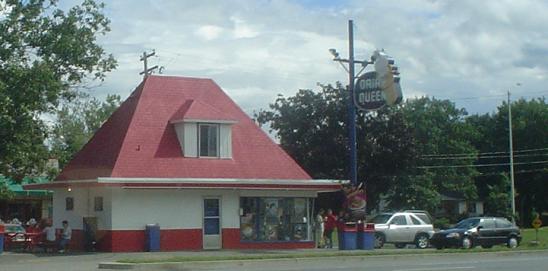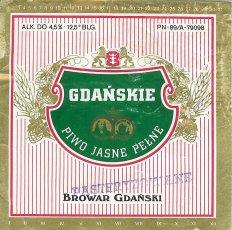I don’t know if it sells a good dillybar, but this old-style Dairy Queen is
just off Quebec Highway 20 at the west end of Montreal at the Ile de Perrot turn
off.
Tag: Food and Drink
Planning for the Finals
So it is Greece v. Portugal. For a kid of Scots immigrants, the fact that two smaller nations have made it to the final game of Euro 2004 is good. It gives some hope that another small nation’s team, wallowing in rebuilding since the 1980s, might be there again one day. But how to celebrate the game?
 V.
V. 
Being Nova Scotian, I had much more contact with Greeks than Portuguese growing up. There were at least two waves of Greek immigration to Nova Scotia which affected my eating habits. As I posted to the replies below, Lunenburg sausage (see reference to it here) is apparently an accurate recollection of the descendants of immigrants by chance who crash landed on the South Shore coast in the 1800s which uses corriander and allspice to flavour the pork. I also grew up in my university days eating at Greek diners like the Spartan at the corner of Oxford and Quinpool, founded by 1950s refugees from a military dictatorship, where 3.99 in 1982 would get you soup, mousakka and rice pudding with four generations of the family having a great time around you. We have some similar diners in Kingston so there may be a brunch there Sunday morning.
For Portugal, I am not so sure what to do other than stock up on the Dão and tawny port. I know that there is a Portuguese dish (in one of the Two Fat Ladies cookbooks I have) called pork and clams with piri-piri sauce. [By the way, I have always wanted to have mahi-mahi with piri-piri sauce on a bed of cous-cous with some kind of cocoa thing for dessert.] But what else can we have for the oldest of allies of the English speaking world?
Oh…and if you are interested in the soccer, here is the Guardian’s take on Greece’s path to the finals.
Four Wittes
Hoegaarden, Ommegang Witte, Unibroue Blanche de Chambly, Brouwerij Sint-Jozef Brussels White
It’s a tough job. Over the last month I assembled this collection of Belgian white beers which are cloudy wheat based ales flavoured with dried orange peel, corriander seed and other traditional spices. It is the best form of beer that perhaps reflects what beer might have been like 400 years ago. The four beers are made (from left to right) in Belgium, New York state, Quebec and Belgium and if you click on the name in the title for the picture above you will find the Beer Advocate reviews for each.
Left to right: Hoegaarden, Ommegang, Unibroue Blanch de Chambley, Brussels White
Not content to read about what people thought I decided to rate them each myself in an entirely scientific process:
- Hoegaarden – this is a beer you can pick up in a six for about $11.00 CND at the Beer Store in Ontario. It is mass manufactured, available everywhere but pretty loyal to the original revival of the style. In fact if this beer had not been saved some years ago the entire style may have been lost. It is the standard, yellow and cloudy, retains a good head and has the most pronounced orangey flavour but it is a subtle difference.
- Ommegang – This rural micro-brewery sits a few miles west of Cooperstown NY. It is the least citrusy and freshest tasting, I suppose something I should expect as I bought it at the brewery. It has a nice rocky head that for me is indicative of home style ales. There is something sweet about it in the US micro style that makes me think that it may have a small amount of corn in the mash. At about $9.00 CND for a 750 ml it is the most expensive. I have had both of Ommegang‘s “dubble” and “quadrubble” and enjoyed them but, compared to Unibroue or Chimay products, they are too hoppy. These beers, the homebrew guides tell us, should be massively malty with two year old hops drained of all their biting acids.
- Blanche de Chambly – The Canadian entry from Quebec’s Unibroue is again available at the Beer Store in Ontario for about $11.00 CND a six pack. It is the least yellow, has a great head. It is a little more lemony than orangey and a bit drier in the Canadian style of ales of having graininess as a pronounced flavour. I have never met a Unibroue ale I have not admired greatly.
- Belgian White – it is a bad thing when the first thing you think of when you sip an ale is minwax furniture polish. Sorry Brouwerij Sint-Jozef. The citrus flavour was like a lemon drop, a yellow lollypop. Gak compared to the rest. It is also the least cloudy and only a skim of yeast at the end of the bottle. The cap was a bit rusty on the edge so it may have been an old bottle but I can’t imagine that caused the lemon drop thing. Put this beer down and walk away backwards slowly. At $2.35 CDN for one 330 ml bottle, it is far more expensive than the Hoegaarden and Blanch de Chambly and far worse.
All the beers are real ales in the sense that there is live yeast in the bottle so expect a skim of sediment – don’t worry, it’s good for you and you should give the bottle a bit of a swirl before you pour the last quarter of the bottle in to the glass. I would buy all but the Belgian White again.
Remember Us?
So…remember they sent two robots to Mars?
They found a salt lick. Some martian spilled the Swiss Chalet sauce a bazillion years ago.
What the World Needs Now…

From today’s BBC News:
German Chancellor Gerhard Schroeder shares a beer with Kazakhstan’s President Nursultan Nazarbayev at the Hanover industrial fair.
Nursultan Nazarbayev: Must we have another, Gerhard?
Gerhard Schroeder: Ja, Nursultan. Then we will see…
The Royal Tavern
My days of bar hopping are long past. The five and a half years of rural life which wrapped up a year ago did its best to kill the habit geographically as did the advent of kids. There are, however, things that are habits and things that are personality traits and I think that the architecture of bars will always interest me. One class could be called the hard little place, that is not a sports bar, not a pub, not a road house. It might be a neighbourhood bar if you didn’t like the neighbours. The old Victory Lounge, formerly in the Lord Nelson Hotel in Halifax, Nova Scotia, or The Green Dory in the Halifax Shopping Centre come to mind as examples as does The Hillsborough Hotel (aka “the hug and slug”) in Pembroke, Ontario. I may, with such an introduction, be slandering the Royal Tavern on Princess street on one particularly non-gentrified block but the place simply does not invite. I would be interested in being proven wrong.
I thought that the adjective “Royal” was not permitted except with government permission. Indeed, as no doubt you all shouted as one at the screen ust now, look up section 10(1)(a) of Ont. Reg 122/91 which makes implying a connection to the Crown a dodgy matter. Did the Queen Mum put in a good word? Maybe she stopped there once in 1937. Most likely the name is saved by section 12(1) and the grandfathering clause for pre 1991 uses. Glad we cleared that up.
The phoney Dickensian touches on the exterior, like the Ye Oldie font illuminated “Tap Room” sign over the door, are intriguing but you can bet the inside will disappoint, that the only thing on tap might be Labatt Blue. Actually it kind of looks like a location for a meeting of toughs on Canada’s first coroner TV drama from the late 60’s, Wojeck.
The mock ecclesiastical glass and angled door, detailed below, are interesting but somewhat weird touches. I will have to look again but it appears that to the left of the building there is a filled in carriage arch which would have led to a back stable. There are still a number of these arches around the town. There is one great one in Charlottetown, PEI in a wooden house on one of the streets behind the former The Harp and Thistle.
Later: The carriage way is confirmed and even advertised. Apparently the place is very old on the inside even having cobbled or stone floors.
The other day I went back to get the exterior of the rear and was glad to see that the old limestone and double dormers are still there. At City Hall, there is a framed 1875 business directory map of the downtown which shows the building as having the twin dormers and an enclosed walled space out back. From the view below of the inelegant car park you can see reminants of the old walls to both sides of the property with the capping of the wall to the left apparently still intact. Likely it was for horse barns and other out buildings, it is kind of nice to imagine a walled ale garden circa 1840. Come to think of it, though, it is three dormers I am looking at with the one to the right being over the carriageway. The carriageway now feeds into the lean-to like addition to the right of the picture.
New USA
The student interns here at Gen X 40 HQ are always looking for new ideas…so here is Fake is the New Real‘s new model USA. I like it because I think Watertown NY is now part of Maine which makes this Shipyard country.

Java based fear
I think I ran out of coffee and forgot to pick any up. Too late now. What’ll I do in 8 hours, bleary, facing nothing but tea? Will I go to work early to get an extra mug in? If you like your boss but you go in early only because you ran out of coffee at home and not to get a start on that report…do you tell him? Can you make a pot of tea with nine bags?
Brew Pub Co-op

I am a bit excited…that’s all…I will be your king…dum-dee-dum…
What a good idea. This is a picture of Chuck looking silly adding hops to a brewing batch of beer… but quite rightly celebrating a local brew pub run as a village co-operative. $4,000 CND gets you into the co-op. It is part of the Campaign for Real Ale’s National Pub Week. I’d pony up for that kind of investment.
Gdansk
Roaming through .jpg files just now I came across this beer label from 1991 in Poland where semi-attentive readers are aware I lived. Buying beer in Eastern Euope then was hit and miss. Local families, in our district of new suburbs, ran shops out of their bottom floors and the beers for sale were those Pan Sklepu would go and get. Supply lines were a bit erratic as a result. So happy were the days when Pivo Gdanskie would show up as opposed to some rot from Slupsk which used cloves instead of hops – but only on some weeks when their hops supply didn’t come through. Nothing as refreshing as the surprise of a bubbly mouthful of cloves.



